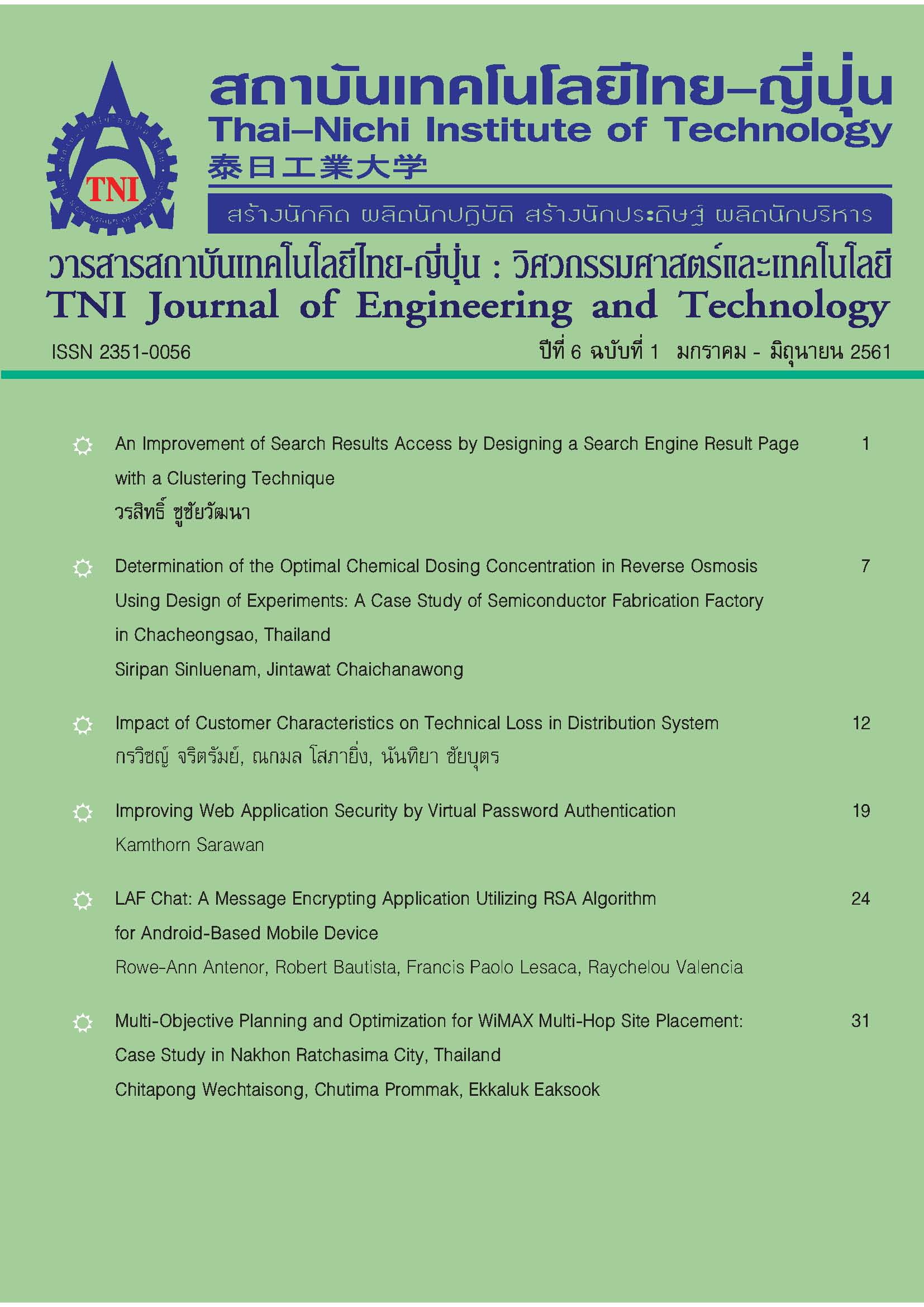Determination of the Optimal Chemical Dosing Concentration in Reverse Osmosis Using Design of Experiments: A Case Study of Semiconductor Fabrication Factory in Chacheongsao, Thailand
Main Article Content
Abstract
The objective of the study was to explore the effects of chemical dosage concentration with respectively to specification of treated Reverse Osmosis water and imply to simulate the optimal amount of chemical in the Reverse Osmosis (RO) process. The study was implied Water Treatment Plant in one semiconductor fabrication in Chacheongsao, Thailand as the case study. The experiment was conducted in the real pilot scale by variation of chemical concentration. Design of Experiment was used to evaluate in term of Analysis of Variance in order to validate the obtained result. Conductivity and % Salt Rejection are key performance indicators. The results developed the optimal range of treated chemical concentration of 10% Antiscalant with 10% Microbiocide solution with RO water conductivity in the range of 5.05-8.51 µS/cm with % Salt rejection in the range 95.12-98.52. The optimal condition could operate approximately to the calculated value from Excel Solver. This condition could reduce feeding chemical consumption amount and help monitoring performance of RO unit.
Article Details
Article Accepting Policy
The editorial board of Thai-Nichi Institute of Technology is pleased to receive articles from lecturers and experts in the fields of engineering and technology written in Thai or English. The academic work submitted for publication must not be published in any other publication before and must not be under consideration of other journal submissions. Therefore, those interested in participating in the dissemination of work and knowledge can submit their article to the editorial board for further submission to the screening committee to consider publishing in the journal. The articles that can be published include solely research articles. Interested persons can prepare their articles by reviewing recommendations for article authors.
Copyright infringement is solely the responsibility of the author(s) of the article. Articles that have been published must be screened and reviewed for quality from qualified experts approved by the editorial board.
The text that appears within each article published in this research journal is a personal opinion of each author, nothing related to Thai-Nichi Institute of Technology, and other faculty members in the institution in any way. Responsibilities and accuracy for the content of each article are owned by each author. If there is any mistake, each author will be responsible for his/her own article(s).
The editorial board reserves the right not to bring any content, views or comments of articles in the Journal of Thai-Nichi Institute of Technology to publish before receiving permission from the authorized author(s) in writing. The published work is the copyright of the Journal of Thai-Nichi Institute of Technology.
References
S. Tan, “Method for Cleaning Semiconductor fabrication equipment parts,” Patent 6810887 B2, 02-Nov-2004.
A. Bennett, “Water processes and production: High and ultra-high purity water,” Filtration & Separation, vol. 46, no. 2, pp. 24–27, Mar. 2009.
“ASTM D5127 - 13 - Standard Guide for Ultra-Pure Water Used in the Electronics and Semiconductor Industries.” [Online]. Available: https://shop.bsigroup.com/ProductDetail/?pid=000000 000030284606. [Accessed: 14-Jan-2016].
I. Sutzkover-Gutman and D. Hasson, “Feed water pretreatment for desalination plants,” Desalination, vol. 264, no. 3, pp. 289–296, Dec. 2010.
L. Henthorne and B. Boysen, “State-of-the-art of reverse osmosis desalination pretreatment,” Desalination, vol. 356, pp. 129–139, Jan. 2015.
B. Zhou, J. Liu, L. Li, X. Chen, and W. Sun, “Evaluation Method for Performance of Reverse Osmosis Antiscalants Based on the Turbidity,” in 2010 International Conference on Electrical and Control Engineering, 2010, pp. 926–929.
D. Kim, S. Jung, J. Sohn, H. Kim, and S. Lee, “Biocide application for controlling biofouling of SWRO membranes — an overview,” Desalination, vol. 238, no. 1, pp. 43–52, Mar. 2009.
M. Al-Shammiri, M. Safar, and M. Al-Dawas, “Evaluation of two different antiscalants in real operation at the Doha research plant,” Desalination, vol. 128, no. 1, pp. 1–16, Mar. 2000.
E. E. A. Ghafour, “Enhancing RO system performance utilizing antiscalants,” Desalination, vol. 153, no. 1, pp. 149–153, Feb 2003.


